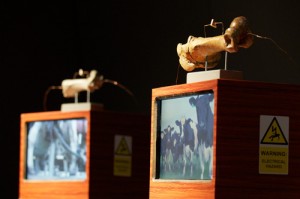Making sounds with bones—but not as you might imagine.

Image from slideshow of Transjuicer exhibit in Science Gallery, Dublin, 2011 and John Curtin Gallery, Perth 2010
Christopher Mims in his Dec. 27, 2011 (?) article for Fast Company explains what artist Boo Chapple is doing with her Transjuicer installation of speakers made from bone tissue,
Turned on its head, bone’s response to physical stress can be used to produce music—or at least musical tones. That’s what artist Boo Chapple discovered during the course of a year-long collaboration at the University of Western Australia’s SymbioticA lab, the only research facility in the world devoted to providing access to wet labs to artists and artistically minded researchers.
When Chapple began this project, she knew that extensive scientific literature suggested bone had what are known as piezoelectric properties. Basically, when a piezoelectric material is bent, compressed, or otherwise physically stressed, it generates an electric charge. Conversely, applying an electric charge to a piezoelectric material can change its shape. This has made piezoelectrics the backbone of countless environmental sensors and tiny actuators.
…
Poring through this literature, Chapple realized that applying a current to bone at just the right frequency should make it vibrate like the diaphragm in an audio speaker. And because bone retains its piezoelectric properties even when it’s no longer living, it should be fairly straightforward to transform any old bone into the world’s most outre audio component.
Because Chapple is an artist and not a technologist, her goal wasn’t to pursue this technique until it yielded a new product. Rather, the point was to accomplish what all good art can: “making strange” otherwise familiar objects.
I first heard about the SymbioticA lab when they showed their Fish & Chips project (the report I’ve linked to is undated) at the 2001 Ars Electronic annual event in Linz, Austria. I never did get to see the performance (fish neurons grown on silicon chips and hooked up to software and musical instruments) but their work remains a source of great interest to me. (I last mentioned SymbioticA in my July 5, 2011 posting where they were scheduled for the same session that I was, at the 2011 ISEA conference in Istanbul.)
Here’s a bit more about the SymbioticA lab at the University of Western Australia (from their home page),
SymbioticA is a research facility dedicated to artistic inquiry into knowledge and technology in the life sciences.
Our research embodies:
- identifying and developing new materials and subjects for artistic manipulation
- researching strategies and implications of presenting living-art in different contexts
- developing technologies and protocols as artistic tool kits.
Having access to scientific laboratories and tools, SymbioticA is in a unique position to offer these resources for artistic research. Therefore, SymbioticA encourages and favours research projects that involve hands on development of technical skills and the use of scientific tools.
The research undertaken at SymbioticA is speculative in nature. SymbioticA strives to support non-utilitarian, curiosity based and philosophically motivated research.
Boo Chapple, a resident at the SymbioticA Lab, had this to say about her installation, Transjuicer, and science when it was at Dublin’s Science Gallery (excerpted from the Visceral Interview),
Do you think that work like yours helps to open up science to public discussion and debate; and does this interest you?
I’m not sure that Transjuicer is so much about science as it is about belief, the economy of human-animal relations, and the politics of material transformation. These are all things that are inherent to the practice of science but perhaps not what one might think of when one thinks of public debate around particular scientific discoveries, or technologies.
While I am interested in the philosophical parameters of these debates, I do not see my art practice as an instrument of communication in this respect, nor is Transjuicer engaged with any hot topics of the moment, or designed in such a way as to reveal the technical processes that were employed in making the bone audio speakers.
The work being done at the SymbioticA lab is provocative in the best sense, i.e., meant to provoke thought and discussion.